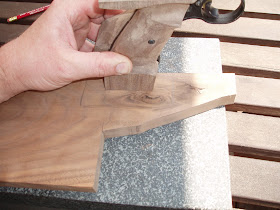
I wanted to make the shelf look like it belonged to the rest of the grip. While it would have been easy to leave it blocky and functional. I wanted an integrated and aesthetic look, too.

I thinned the underside of the front with a curve.

Decided to put a sloped curve on the rear of the shelf and continue that curve through the left-side grip. It's about 85% finished here.

Continuing that curve up the left grip. Note that the grips are bolted to a spare grip frame and being worked as one piece.

Still finding pressure points on the grip as well. A pencil scribble on the top of the right grip marks the area for some sanding attention. It's never too late to fine tune the grip to hand fit.

Remember that 1/4" thick spacer?

It's glued to the inside of the right grip panel. I mentioned previously that I'd deepened the slots for the palm shelf adjustment bolts. The relief grooves now go just high enough above the spacer that I can drop the 6-32 square nuts in from the top. This allows for a damaged square nut fastener to be replaced effortlessly.

Spacer positioned with both grip panels bolted in place then clamped.

While the glue dried, I got out a surface plate and finish sanded the shelf.

Here's a good shot of the curved front.

Done.

Spacer stands proud of the grip, ready for fitting.

The spacer was sanded down in just a couple minutes. You now have to look hard to find the transition line. Only the slight grain direction difference gives it away.

Finish sanded both grips. I was prepared to stipple the gripping areas, but was talked out of it--at least for now. Areas to be stippled really don't need to be sanded past about 120 grit. In this case, the entire grip was sanded to 300 something grit.

A coat of filler...

After they've dried.

Then the grip is rubbed down with 0000 steel wool and some of this stuff until there's no gloss left from the filler.

Just a bit of boiled linseed oil and some polishing with a rag.
Some "glamour shots":





Overall, I'm quite pleased with the way the grips turned out. Most importantly, they fit my hand far better than I could have hoped. While a Crosman 22XX isn't a 10-meter target pistol by any stretch, with a simple trigger job and some practice, it's a fantastic shooter for such a minimal cash outlay.




































